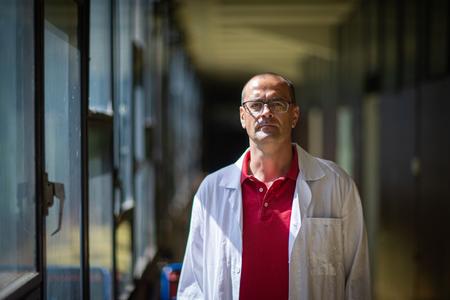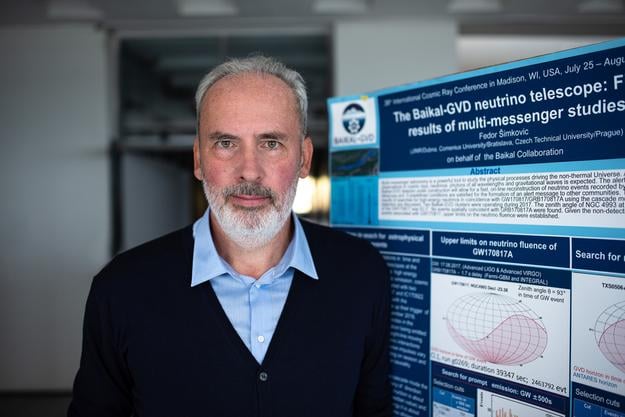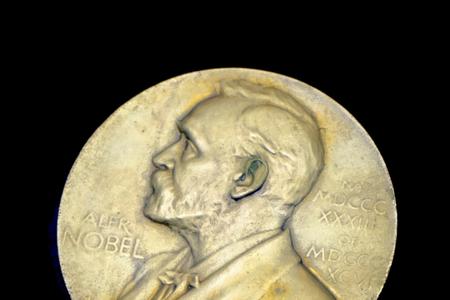"Thousands of billions of neutrinos stream through our bodies each second," says nuclear physicist Fedor Šimkovic from the Department of Nuclear Physics and Biophysics at Comenius University in Bratislava.
Although the existence of the neutrino was postulated almost a century ago, and its existence confirmed 66 years ago, there are still many underlying mysteries surrounding it. Together with a team of young physicists, scientist Fedor Šimkovic is seeking answers to these nagging questions and, by extension, hoping to learn new things about the nature of the universe.
Neutrinos remain the most mysterious of fundamental particles. What is it we still do not know?
We still do not know the answers to several basic questions, such as the absolute neutrino mass scale [i.e. how much neutrinos weigh], their spatial and charge symmetry properties, and the possible existence of additional sterile neutrinos. One of the leading unanswered questions about neutrinos is whether they are Majorana particles – i.e. whether neutrinos are their own antiparticles – or Dirac particles – i.e. if neutrinos have antiparticles like most other particles in the Standard Model.
This problem is closely related to the origin of neutrino masses. The evidence for tiny neutrino masses from observation of neutrino oscillation is the first proof of physics beyond the Standard Model. A complete reconstruction of the neutrino mass spectrum may point to the theoretical structures underlying the Standard Model, such as supersymmetry, string theory, extra space dimensions, etc.
What is a neutrino?
According to the Standard Model of particle physics, the universe is built from 12 fundamental particles: three families of leptons – electron, muon and tau, and their corresponding neutrinos – and quarks. Neutrinos are the most abundant, and come in three types or flavours – electron neutrino, muon neutrino and tau neutrino.
They can change from one flavour to another as they travel. This unusual process is called neutrino oscillation and is a consequence of the quantum mechanical origin of the micro world. Neutrinos play a crucial role in understanding the evolution of the universe, the processes within it, and the fundamental laws of nature.
To stay up to date with what scientists in Slovakia or Slovak scientists around the world are doing, subscribe to the Slovak Science newsletter, which will be sent to readers free of charge four times a year.
What do you mean by that?
Today, scientists are opening a new window into the universe through neutrinos, one that tells us a lot about its make-up and the history of the stars and galaxies. This new field, called neutrino astronomy, might reveal new, unknown phenomena and help us answer several of the questions we have today. In particular, why does matter dominate over antimatter – something which we practically do not observe?
Relic neutrinos, a remnant of the Big Bang, can explain the origin of dark matter in the universe. Neutrinos are generally accepted as unique probes for the interior of stars, the Earth and nuclear reactors. There are some suggestions that neutrinos could be used to discover oil and other mineral deposits, for global communication, or to communicate with extraterrestrial life. Today’s utopia is tomorrow’s reality.
The neutrino was postulated in 1930. Why is it that we know so little about a particle that has been studied for so long?
There are several reasons that, until now, we know relatively little about neutrinos. Studying them requires exploring their natural sources, such as stars or artificial sources like reactors and accelerators, constructing sophisticated detectors to register the products of neutrino reactions via detection mediums, suppressing background events in the detector that mimic signal events – and also having a good basis for the research.
The main problem with studying neutrinos is that they are elusive subatomic particles that rarely interact with anything. Of the four fundamental forces in the universe, they do not interact via the two strongest of these, namely the strong force, which holds the atomic nucleus together, nor through the electromagnetic force, which requires the presence of an electrical charge and binds the electrons in an atom. Neutrinos possess no electric charge and interact through the weak force that is responsible for the radioactive decay of atoms and the significantly weaker gravitational force, whose interaction is even further suppressed due to the tiny mass of neutrinos compared to other subatomic particles.
After they were postulated, it took 26 years until we got experimental evidence. For that we must thank the construction of nuclear power plants. In 1962, when a neutrino beam was made with the help of a particle accelerator, the second kind of neutrino – the muon neutrino – was discovered. The tau neutrino, a cousin to the other two neutrinos, was detected with a more powerful neutrino beam produced using accelerated protons in 2000. In all these cases, physicists detected neutrinos only after creating them with devices that they had constructed themselves.
For a long time, a majority of the physics community believed neutrinos had zero mass, as postulated in the Standard Model. The discovery of neutrino oscillation, which is tangible proof of non-zero neutrino masses, has changed the situation. We are following a boom in neutrino physics that combines cosmology with astrophysics, elementary particle physics, and the study of the atomic nucleus. More and more new experiments are being built worldwide.
Where do neutrinos come from?
The most abundant neutrinos were created in the universe’s first second, just after the Big Bang, when there was enough energy to make all the particles and antiparticles. Since they cannot decay into anything, they should still be here. Due to their very, very low energy, which is a result of the universe’s expansion, they have not been experimentally confirmed yet. Low-energy neutrinos are produced mainly from nuclear reactions. In particular, they are continually being created in the nuclear fusion processes of stars.
They are also produced by the decay of radioactive uranium and thorium inside the Earth, and by the nuclear reactions governing the explosion of supernovae. Cosmic-ray interactions with atmospheric molecules produce a flux of neutrinos in all directions. Ultra high-energy neutrinos are assumed to be produced in cosmic accelerators, such as nearby magnetized neutron stars or in the region of the accretion disks of black holes. Low- and high-energy neutrinos can also be produced in manmade atomic reactors and particle accelerators on Earth.
How do they interact with the environment?
Neutrinos are tough to catch because they rarely interact with anything in existence due to their zero charges and nearly zero mass. They flow through matter like light rays passing through a transparent window.
Even our bodies?
Thousands of billions of neutrinos are streaming through our bodies each second. The probability is that each of us will interact with a cosmic neutrino only once in our lifetime – and will be unaware of it even when we do.
What do the experiments designed to capture neutrinos look like?
The detection method depends on the neutrino’s energy and its flavour. The energy of a neutrino hinges on the process that formed it. For low-energy neutrinos, all matter, including stars, is transparent. By contrast, the Earth is not fully transparent to ultra-high-energy neutrinos from galactic and extragalactic sources. We detect neutrinos only indirectly via different modes of weak interaction with matter. That is, when a neutrino transfers some of its momentum to another particle, and then that particle is detected, or when a neutrino is transformed into an electron, muon or tau. But again, the main problem is that these reactions happen rarely, especially for low-energy neutrinos.
Experiments designed to capture neutrinos are carried out deep underground. Why?
As these reactions happen only rarely, detectors must always be gigantic to allow enough neutrinos to pass through enough matter and make as much of it as possible available for an interaction to occur. The experiments are located deep underground or underwater – in the case of neutrino telescopes – to suppress background processes, primarily those originating in cosmic rays. Otherwise, muons produced in cosmic ray interactions in the Earth’s atmosphere could reach the detector and thus mimic neutrino events directly or through secondary processes.
A reduced muon flux allows the probing of rare neutrino events, even dark matter particle interactions. Deep-underground laboratories are research infrastructures built under a rock overburden greater than about 1,000 metres. The larger the overburden, the more significant the reduction in the muon flux. Some underground laboratories are located in deep mines, and some of them are in highway tunnels.
How many such laboratories are there?
Currently, 14 deep-underground laboratories are in operation worldwide, and three are under construction, with a timescale of one to seven years. Neutrino telescopes, the primary task of which is to detect ultra-high energy neutrinos from local sources, have been built or are under construction in the ice of the South Pole, in the Mediterranean, and in Lake Baikal.
You had a chance to directly participate in the construction of the largest neutrino telescope in the Northern hemisphere, in Lake Baikal. What does that experiment look like?
It is a structure located four kilometres from the shore that extends one-and-a-half kilometres down to the bottom of the lake. The neutrino telescope consists of optical modules mounted on ropes, plus the necessary accompanying cables. Eight such strings form a cluster with a circular base.
Today we already have ten operating. The detection medium is water: the water in Baikal is very clean, suitable even for drinking. Optical modules collect light from processes with neutrinos and cosmic rays. The signals accumulate at the lake shore station and are sent to the town of Baykalsk, 40 kilometres away, from where they travel via fibre to the Joint Institute for Nuclear Research, or JINR*, in Dubna [near Moscow] for further processing and storage. The detector is being expanded further.
Two expeditions are organized each year. In summer, work is done to prepare for the winter expedition, when the telescope is built from the lake’s frozen surface. We cut a hole in the ice, run the ropes with optical modules into it and connect them with cables to the coastal centre. Our group helps in building the telescope and especially in processing data, due to the particle physics processes in it.
When can we expect results? What will these bring to people?
Neutrino telescopes, particularly the Baikal-GVD neutrino telescope, allow us to search for something interesting happening in the distant universe. Of particular interest are neutrinos that fly into the detector after travelling through the Earth, which other cosmic particles cannot. The goal is to locate and understand the point sources of cosmic neutrinos in space. One of these could be a black hole at the centre of our galaxy.
There is also an interest in obtaining information about high-energy neutrinos from outside our galaxy and relating these to cosmic phenomena that we do not yet know about. Exciting events from the neutrino telescope can appear at any time, of which there are already some indications. Recently, to verify and understand the processes in the depths of the universe, so-called ‘multi-messenger astronomy’ was created, which is based on the coordinated observation and interpretation of diverse signals from space. It includes registering electromagnetic radiation, gravitational waves, neutrinos, and cosmic rays.
Although we don’t know much about neutrinos, they have already contributed significantly to our understanding of nature. Four Nobel Prizes have been awarded for neutrino physics so far and there is potential for more. It is hard to predict the future importance of neutrino physics technologies for humanity. One idea is that beams of neutrinos could serve as a vehicle for direct point-to-point global communications, secure means of communication, and even interstellar communication. Neutrino beam communication could even enable continuous communication with Mars without relying on satellites or the need to deploy antennas.
What does research in this area look like in Slovakia?
The neutrino physics research in Slovakia is realized at the Faculty of Mathematics, Physics and Informatics at Comenius University in Bratislava. I established a team of young physicists who work on problems of three prominent neutrino physics experiments. First, as mentioned, we are members of the Baikal-GVD collaboration and participate in data analysis and construction of the detector.
Second, we collaborate on the SuperNEMO project, which aims to observe the neutrino-less double beta decay signal in a detector at the Modane underground laboratory in France. The subjects of our interest are background processes and physical interpretation of data. The third experiment is JUNO, which is being built in China. It will observe neutrino oscillations from two reactors, 53 kilometres apart. The priority is to discover something about the mass spectrum of neutrinos. Among other things, we have also developed a neutrino-less double beta nuclear decay theory, which is of great interest to the scientific community.
You mentioned that there is potential for further Nobel Prizes in neutrino physics. People in Slovakia hope that one of their scientists will one day become a Nobel laureate, and that one of the most probable fields is physics. Do you think this could happen based on research related to neutrinos?
I don’t know about other fields, but I don’t see the potential yet regarding particle and nuclear physics. The position of our universities in the World University Rankings is not the best. We profit from scientific contacts with excellent scientific institutes in Europe and worldwide, and the situation is slowly improving.
Realistically speaking, I do not think there will be a Nobel Prize in the near future. But there is still a chance a miracle like Peter Sagan or Petra Vlhová might appear, if I can draw a parallel with the situation in sport. Of course, I would be happy if it did happen.
Why do you focus on neutrinos?
Neutrino physics is exciting and full of thrilling discoveries. Neutrinos remain the most mysterious fundamental particles, and we still do not know the answers to basic questions. It might also be that I am ambitious. I hope to contribute to or solve the problem of neutrino masses – mass spectrum, the origin of neutrino masses – and determine the nature of neutrinos.
*Slovakia’s cooperation with the JINR has been suspended following the Russian invasion of Ukraine.
This article is supported by the ESET Foundation, which awards the ESET Science Award to exceptional scientists every year.








